
7 climbing flowers in pink
Our selection of pink climbing plants for the garden or terrace
Contents
Climbing plants impress us with their voluble lianas and their flowers blooming from spring or summer to autumn. Pink-flowering climbers are among the most charming, romantic in soft shades or more vibrant in striking pink hues.
Here is a selection of pink-flowering climbing plants, often fragrant, hardy for all gardens across the hexagon or a bit more delicate for planting in the south or along the coast.
Clematis 'Asao'
Numerous pink clematis are of interest. The highlight of the Japanese ’Asao’? It boasts very beautiful and large flowers measuring 15 to 18 cm in diameter. Its colour is a crimson pink, deep at the edges of the petals, lighter on the almost white midribs, with a contrasting heart of sulphur yellow anthers. It blooms abundantly in spring, around May or June, then flowers again in September. The foliage emerges in a lovely bronze colour in spring. This clematis is of intermediate size, relatively compact, growing up to 2 to 3 m tall, but only 1 to 1.5 m wide, making it perfect for pot cultivation or small gardens.
It should be planted in full sun or partial shade, in any soil, as long as it is well-drained, always keeping in mind the saying ‘head in the sun and feet in the shade’!

Clematis ‘Asao’
Read also
Clematis: which variety to choose?Wattakaka sinensis or Dregea sinensis: exotic and voluble
It is a climbing plant with a very pale pink hue, still too rare in gardens, a liana with a funny name, but you will certainly remember it after discovering its many qualities. Native to China and Tibet, Wattakaka sinensis, now more commonly referred to as Dregea sinensis or Chinese Drégée, blooms in late spring, from May to mid-July. It is covered in small star-shaped flowers, grouped in umbels, which are highly fragrant in the late evening. The very delicate colour is a old rose at the heart of the flower and white on the petals.
Climbing vigorously and quickly up to 6 or 7 m and spreading 2 to 3 m, the flowering unfolds on large heart-shaped (cordiform) leaves, light green, deciduous, beautifully veined, and slightly undulate. Its foliage and flowering give it a particularly interesting exotic look, but you can also use it in a romantic garden as it is delicate and charming.
Provide it with a location in very light shade or full sun, in any sufficiently rich and cool soil (a mulch at its base will be helpful, although it can tolerate drought once established), at the foot of a tree, arch, or pergola. Wattakaka is hardy down to -12 °C.
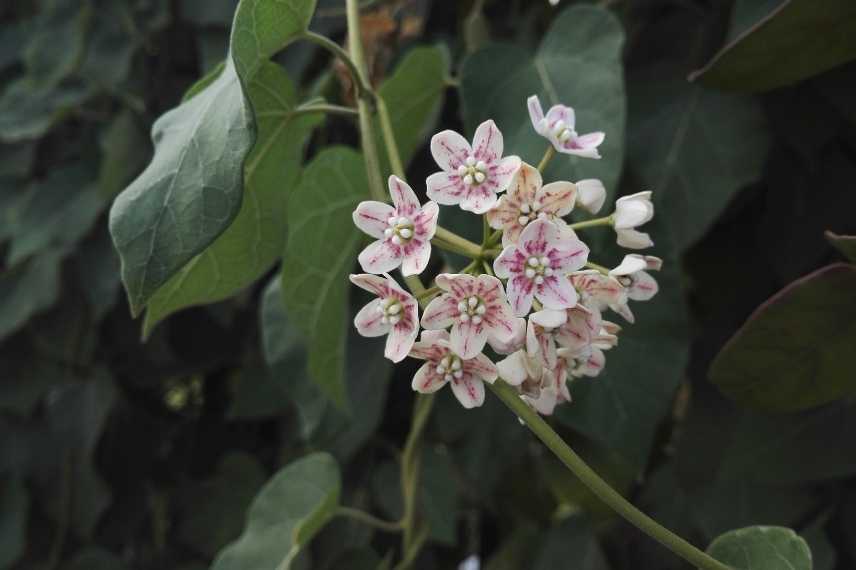
Wattakaka (or Dregea) sinensis
Discover other Climbers
View all →Available in 0 sizes
Available in 0 sizes
Available in 0 sizes
Available in 0 sizes
Available in 0 sizes
Available in 0 sizes
Available in 0 sizes
Available in 1 sizes
Available in 1 sizes
Available in 1 sizes
Climbing rose 'Cyclamen Pierre de Ronsard'
Difficult to present just one climbing rose or liana in this selection as roses are the stars among climbing plants! How about the charm of the iconic Pierre de Ronsard rose, in a slightly more vibrant colour? Created in 2017 by Meilland, here is the climbing rose ‘Cyclamen Pierre de Ronsard’, a happy marriage of the romanticism of old roses with their countless petals and a deep, intense pink colour, almost silvery on their reverse. The flowers appear at the end of May or in June depending on the regions, and will continue to bloom until September, provided you prune the faded inflorescences to encourage new growth. The roses, like those of Pierre de Ronsard, are generous, about 12 cm in diameter, and the rose bush reaches nearly 3 m in height, with a spread of 1.50 m.
This rose requires a very sunny position to bloom abundantly and prefers fresh soil. Just like the classic Pierre de Ronsard, it should be avoided in very rainy regions, as excessive moisture can damage the sublime roses. Elsewhere, the ‘Cyclamen Pierre de Ronsard’ will delight you with its grace and vibrant pink colour all summer long, trained against the wall of your house, on an old trellis, or climbing an arch or a beautiful obelisk!
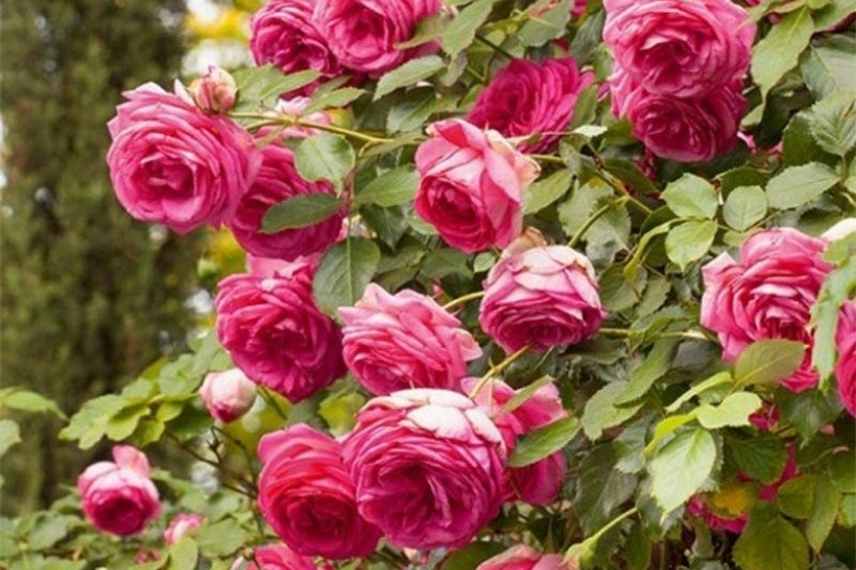
Climbing Rose Cyclamen Pierre de Ronsard
Read also
6 climbing plants for coastal areasPodranea ricasoliana
Here is a climbing plant that closely resembles a trumpet vine: it indeed belongs to the same family, but the Podranea ricasoliana is not a Campsis; it hails from South Africa, whereas the trumpet vine comes from China or the United States. This means that this beautiful South African plant is much more frost-sensitive, suitable only for coastal gardens (it can withstand negative temperatures down to -5 °C, if very sheltered in a south-facing position). Like the trumpet vine, it is semi-woody, but also climbing up to 2 to 3 m in all directions, more in favourable conditions. This “pink trumpet vine” delights us with stunning trumpet-shaped flowers in soft pink veined with red at its heart from late summer until mid-autumn. It is a wonderful climbing plant, to be trained in the sun, in cool, well-drained soil, against a granite wall in Brittany or a façade in the south. Its foliage is deciduous or semi-evergreen, and even evergreen on the Mediterranean fringe. Be particularly careful to protect it from the cold during the first few years while it establishes itself.
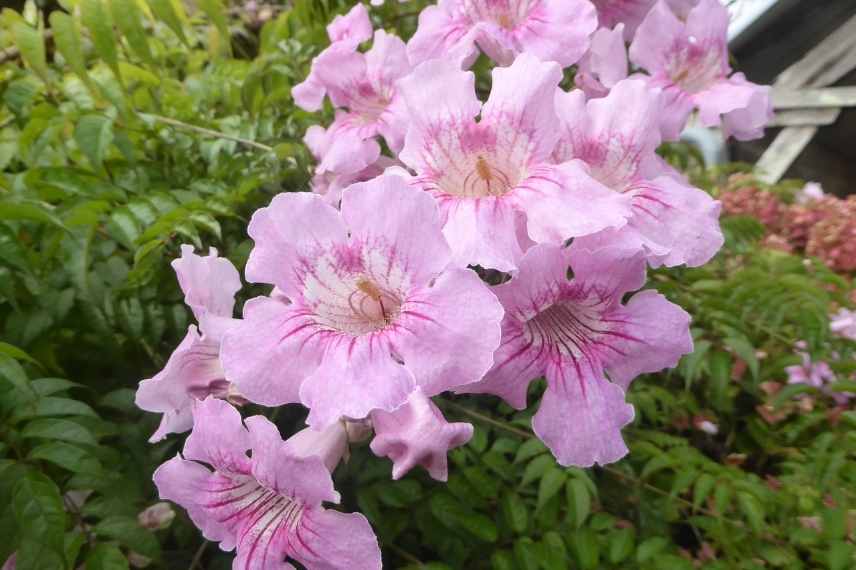
Podranea ricasoliana (© Gwenaëlle David)
The Asian Trachelospermum ‘Pink Showers’
While star jasmines are known for their powerful fragrance emanating from their star-shaped flowers, one stands out with its pink colour: the Trachelospermum asiaticum ‘Pink Showers’. This relatively recent cultivar from 2016 is derived from the false jasmine, a Trachelospermum native to Japan, also known as star jasmine. Its flowers appear from May to June, sometimes into July. They are just as fragrant as those of the species type, and are a soft, delicate pink, forming rolled star shapes with a small yellow centre, about 4 cm in diameter. Its foliage is evergreen and leathery, sometimes tinged with red during cold winters. This type of climbing plant requires plenty of sunlight and should be trained as it begins to grow.
‘Pink Showers’ grows quite slowly in the first few years, reaching about 3 m in height and approximately 1.5 m in spread within a few years. You can cultivate it in a pot on a terrace, where it will remain smaller. It is hardy down to -12 °C in a sheltered position.
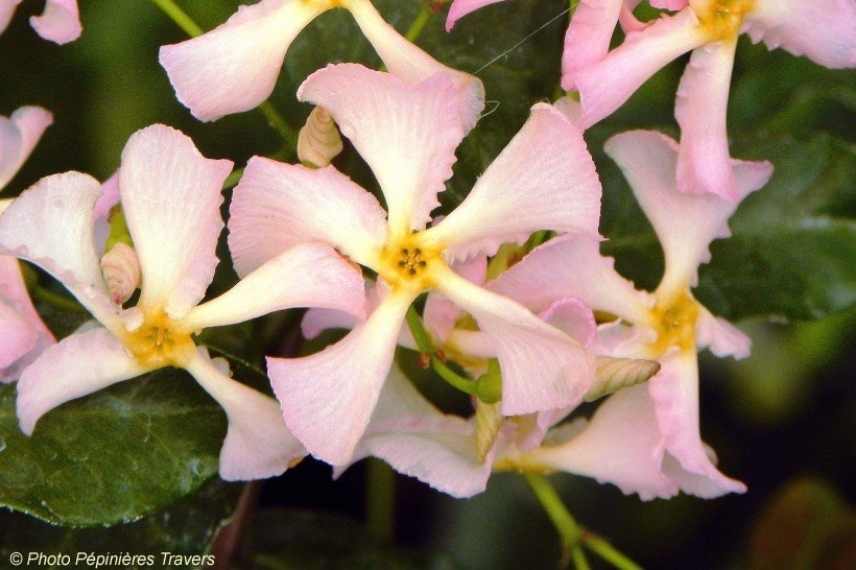
Trachelospermum asiaticum ‘Pink Showers’
Bougainvillea glabra 'Sanderiana'
Among the most spectacular climbing plants… when living on the coast or the Mediterranean shoreline… Bougainvillea stands out for the vibrancy of its colours and its floribundity. Bougainvilleas are often mauve or violet, sometimes orange, but a particularly beautiful cultivar captivates us with its bright pink colour: the glabrous bougainvillea ‘Sanderiana’. Climbing easily to 6-8 m in height when mature, it spreads generously over nearly 6 m. This climbing plant impresses with its size and its colour, which is more pink than most bougainvilleas: it features an ultra-bright violet-pink hue that covers the foliage from May to September, even October. ‘Sanderiana’ requires rich, well-drained soil.
Choose a prime location – the facade of a large house, a spacious pergola, or even a large pot (it will be much more modest in size in this case), as this remarkable bougainvillea can climb up to 8 m. It is not frost-resistant.

Bougainvillea glabra ‘Sanderiana’ (© Jnzl’s photos)
Jasminum x stephanense
Jasmines are dreamy, and one might think they are all reserved for southern gardeners… However, this is not the case with the Stéphanois Jasmine, also known as pink jasmine or Jasminum x stephanense. It can adorn trellises and pergolas even in the north, provided its base is well protected with mulch and it is placed against a sheltered wall; it is then capable of withstanding some frosts down to -15 °C. Pink jasmine is a beautiful climbing plant that is underused, bearing a myriad of small star-shaped tubular flowers in soft pink, grouped in clusters of 4 or 5 at the tips of the stems. The flower buds are a darker pink, making the start of flowering particularly delightful. Flowering begins in June and continues, depending on the climate, until August. This pink jasmine easily reaches 3 to 4 m in height, with a medium growth rate. Its light green foliage remains in place in mild regions, while in other areas it will be deciduous to semi-evergreen.
This jasmine is delicately scented, so place it near an entrance or pathway. It adds a charming touch to romantic gardens and a lovely exuberance in pots for sunny, sheltered terraces.
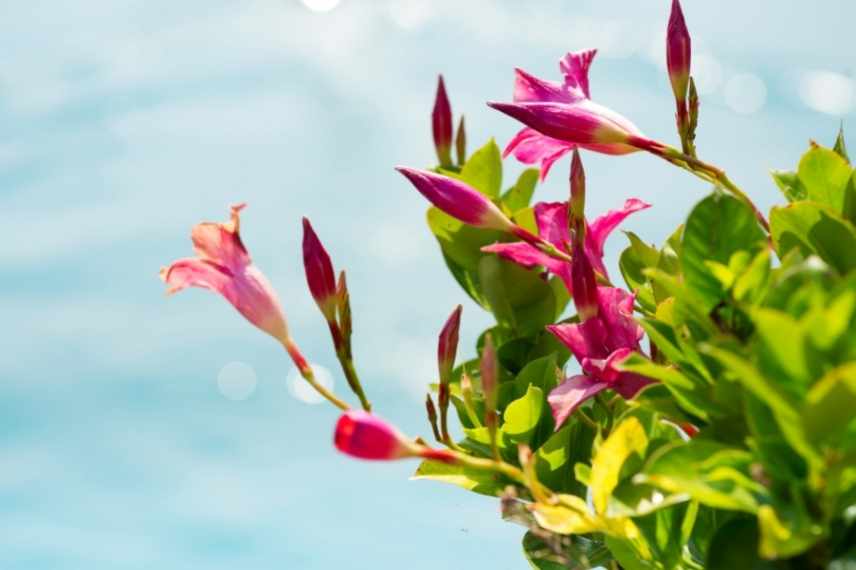
Jasminum x stephanense
- Subscribe!
- Contents
































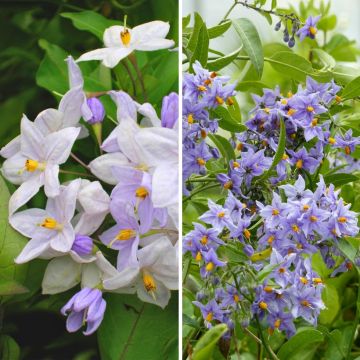
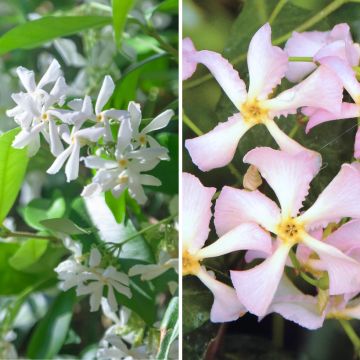
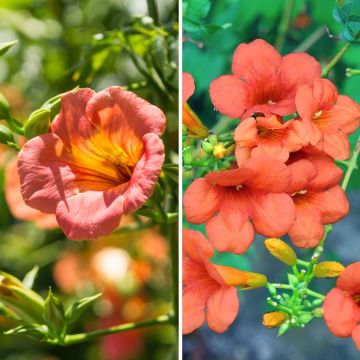
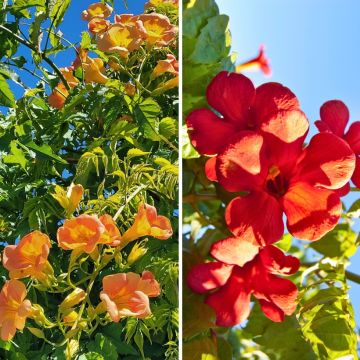
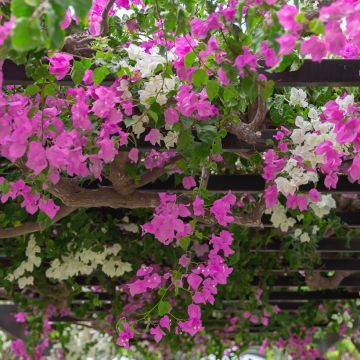
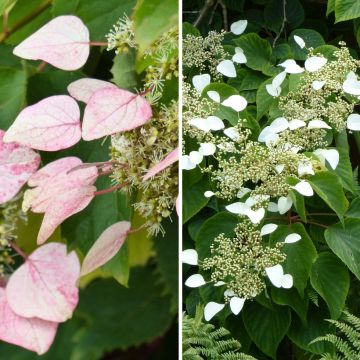
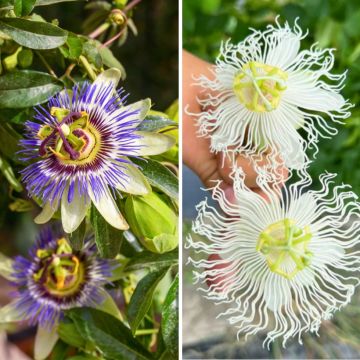
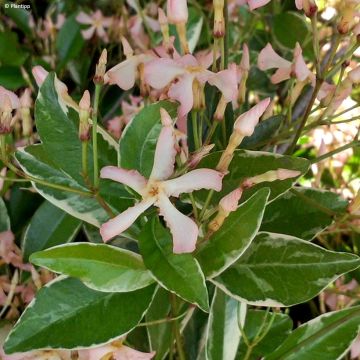
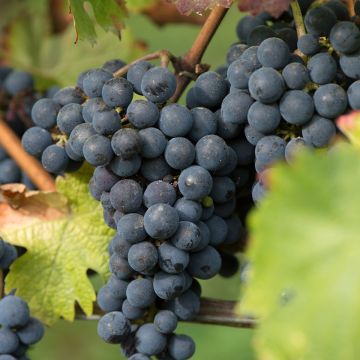
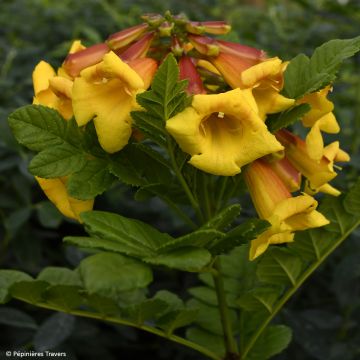
Comments